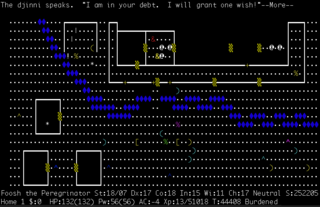
NetHack is an open source single-player roguelike video game, first released in 1987 and maintained by the NetHack DevTeam. The game is a software fork of the 1982 game Hack, itself inspired by the 1980 game Rogue. The player takes the role as one of several pre-defined character classes to descend through multiple dungeon floors, fighting monsters and collecting treasure, to recover the "Amulet of Yendor" at the lowest floor and then escape. As a traditional roguelike, NetHack features procedural-generated dungeons and treasure, hack and slash combat, tile-based gameplay, and permadeath, forcing the player to restart anew should their character die. While Rogue, Hack and other earlier roguelikes stayed true to a high fantasy setting, NetHack introduced humorous and anachronistic elements over time, including popular cultural reference to works such as Discworld and Raiders of the Lost Ark.

Roguelike is a subgenre of role-playing video games characterized by a dungeon crawl through procedurally generated levels, turn-based gameplay, tile-based graphics, and permanent death of the player character. Most roguelikes are based on a high fantasy narrative, reflecting their influence from tabletop role playing games such as Dungeons & Dragons.
Ancient Domains of Mystery is a roguelike video game, designed and developed by Thomas Biskup, which was released in 1994. The player's goal is to stop the forces of Chaos that invade the world of Ancardia. It's identified as one of the "major roguelikes" by John Harris.
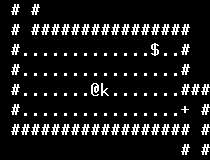
The Dungeons of Moria, or just Moria, is a roguelike computer game inspired by J. R. R. Tolkien's novel The Lord of the Rings. The game's objective is to kill a Balrog, presumably Durin's Bane, deep within the Mines of Moria. A later port of Moria called Umoria inspired the Angband roguelike game. This game influenced the preliminary design of Blizzard Entertainment's Diablo.

Rogue is a dungeon crawling video game by Michael Toy and Glenn Wichman and later contributions by Ken Arnold. Rogue was originally developed around 1980 for Unix-based mainframe systems as a freely-distributed executable. It was later included in the official Berkeley Software Distribution 4.2 operating system (4.2BSD). Commercial ports of the game for a range of personal computers were made by Toy, Wichman, and Jon Lane under the company A.I. Design and financially supported by the Epyx software publishers. Additional ports to modern systems have been made since by other parties using the game's now-open source code.

Pool of Radiance is a role-playing video game developed and published by Strategic Simulations, Inc (SSI) in 1988. It was the first adaptation of TSR's Advanced Dungeons & Dragons (AD&D) fantasy role-playing game for home computers, becoming the first episode in a four-part series of D&D computer adventure games. The other games in the "Gold Box" series used the game engine pioneered in Pool of Radiance, as did later D&D titles such as the Neverwinter Nights online game. Pool of Radiance takes place in the Forgotten Realms fantasy setting, with the action centered in and around the port city of Phlan.

Akalabeth: World of Doom is a role-playing video game that had a limited release in 1979 and was then published by California Pacific Computer Company for the Apple II in 1980. Richard Garriott designed the game as a hobbyist project, which is now recognized as one of the earliest known examples of a role-playing video game and as a predecessor of the Ultima series of games that started Garriott's career.

Curse of the Azure Bonds is a role-playing video game developed and published by Strategic Simulations, Inc (SSI) in 1989. It is the second in a four-part series of Forgotten Realms Advanced Dungeons & Dragons Gold Box adventure computer games, continuing the events after the first part, Pool of Radiance.
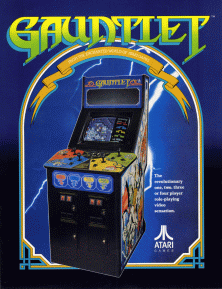
Gauntlet is a 1985 fantasy-themed hack and slash arcade game by Atari Games. It is noted as being one of the first multiplayer dungeon crawl arcade games. The core design of Gauntlet comes from Dandy, a 1983 Atari 8-bit family dungeon crawl, which resulted in a threat of legal action.

Sword of Fargoal is a dungeon exploration video game by Jeff McCord, published by Epyx for the VIC-20 in 1982 and the Commodore 64 in 1983. The game was originally released on cassette tape and 5¼" floppy disk formats.
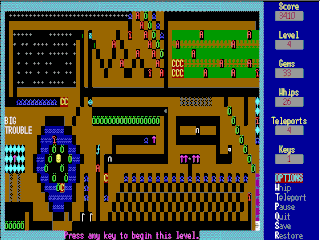
Kroz is a series of Roguelike video games created by Scott Miller for IBM PC compatibles. The first episode in the series, Kingdom of Kroz, was released in 1987 as Apogee Software's first game. It was also published on Big Blue Disk #20. Kroz introduced the scheme of the first episode being free and charging money for additional episodes; a technique which defined the business model for Apogee and was adopted by other MS-DOS shareware publishers.

Dungeon Hack is a role-playing video game developed by DreamForge Intertainment and published by Strategic Simulations for DOS and NEC PC-9801 in 1993. The game is based in the Advanced Dungeons and Dragons world of Forgotten Realms.
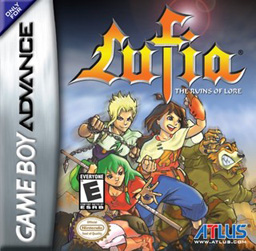
Lufia: The Ruins of Lore, known in Japan as Chinmoku no Iseki: Estpolis Gaiden, is a role-playing video game developed by Atelier Double and published by Taito in Japan in 2002 and by Atlus a year later in North America. It is the fourth title in the Lufia series of video games and was released as a "gaiden", or side story, to the main series; as a result, it does not feature many elements common to the rest of the series, such as the Sinistrals and the Dual Blade.
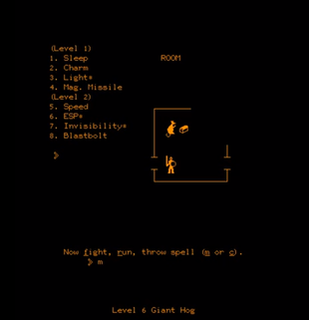
pedit5, alternately called The Dungeon is a 1975 dungeon crawl video game developed for the PLATO system by Rusty Rutherford. It is considered to be the first example of a dungeon crawl game, believed only to be preceded by a game named m199h listed among some PLATO lesson lists but which no copies exist to affirm.
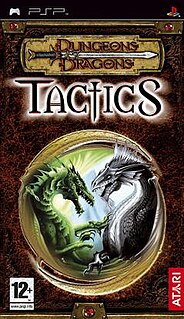
Dungeons & Dragons Tactics is a tactical role-playing game released on the PlayStation Portable handheld video game console. It is set in the world of Dungeons & Dragons and uses a strict interpretation of the Dungeons & Dragons 3.5 Edition rule set.

Swords and Serpents is a fantasy role-playing video game developed by Interplay Productions for the Nintendo Entertainment System. In this game, the player controls a party of four adventurers on a dungeon-crawling quest to destroy a terrible serpent. Along the way, the party encounters an onslaught of fantasy monsters and collects gold and treasure while gaining experience points needed to raise their individual attributes. Swords and Serpents focuses mainly on gameplay and contains very little plot development.
Ancients 1: Death Watch is a first-person medieval fantasy turn-based RPG for the PC. Version 1.2 was released as shareware in 1991, developed and self-published by Farr-Ware. Version 2.0 was later published by Epic MegaGames on August 12 of 1993. The game was programmed by Mark Lewis, and its graphic art was created by Jason Struck and Matthew McEwan.

Inner Worlds is a 1996 fantasy platform game by Sleepless Software Inc. incorporating some RPG elements. The game is concentrated on a werewolf character called Nikita who travels through a magical world fighting monsters and learning spells.

Shadowlands is a 1992 video game developed by Domark for DOS, Amiga, and Atari ST.
Pool of Radiance is a series of role-playing video games set in the Forgotten Realms campaign settings of Dungeons & Dragons; it was the first Dungeons & Dragons video game series to be based on the Advanced Dungeons & Dragons rules.















